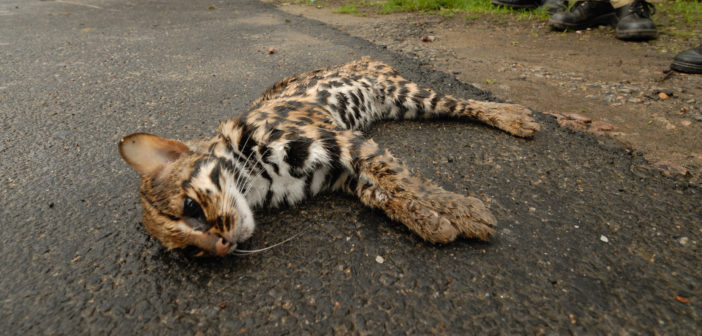Friends of the Earth Malaysia (FOEM) is appalled at the frequent occurrences of road kills affecting our endangered species. It has been reported that since 2011, 1,110 wild mammals – including civets, wild boars, marbled cats, tapirs, and others – have been killed in road accidents across Malaysia.
According to the Minister of Natural Resources and Environment (July 14, 2016 – Bernama), protected species were killed on 61 different federal, state and municipal roads and highway networks.
Not surprisingly, most accidents took place in or near forested areas, where wild animals must cross roads to get from one forest area to another.
Despite FOEM and other wildlife NGOs highlighting the harmful effects of roads on wildlife, road density continues to increase with roads criss-crossing the country.
Federal and state governments and local transportation departments devote huge budgets to construction and upgrading of roads. Multinational lending institutions, such as the World Bank, finance roads that dissect the pristine rainforest, and usher in floods of settlers who destroy both the rainforest and the indigenous cultures inhabiting it. Public land-managing agencies build thousands of miles of roads each year to support their resource extraction activities. Most public agencies disregard the ecological impacts of roads, and attempt to justify logging roads as benefiting the public and wildlife management.
Although the effects of different types of roads vary, virtually all are bad for wild animals, and the net effect of all roads combined is nothing short of catastrophic.
Roadkill has a significant impact on wildlife population. Animals are at greatest risk from vehicles on high speed highways. Unimproved, unpaved roads are less dangerous. Increases in traffic volume result in more collisions on any given road, and in our profligate society, more people means more cars on virtually every road.
While roadkill statistics take into account the number of mammals found dead on roads, do they account for animals that crawl off the road to die after being hit? What about the numbers of reptiles, amphibians, invertebrates and birds? Snakes are particularly vulnerable to roadkill, as the warm asphalt attracts them during the day. What about the thousands of insects smashed on windshields?
Despite signboards at animal crossings, transverse bars, solar amber lights, animal viaducts, tunnels and pathways at locations with the highest number of roadkills, wildlife continues to perish. The questions that need to be asked are: ‘How effective are marked animal crossings in ensuring a lessening of roadkills?’ and, ‘Have any studies been conducted to find the percentage of wildlife using the constructed animal crossings?’
In fact, roadkills should not occur at all, given proper planning among the various agencies before construction of roads and highways through wildlife habitats.
Roads are major threats to the survival of wildlife. They act as a displacement factor affecting animal distribution and movement patterns. Animal populations fragment when access corridors are created that traverse national forests, and encourage further development and logging. Poaching of rare plants and animals also increases with roads, threatening the very existence of the forests’ rare flora and fauna.
Humans incessantly demand new roads for connectivity, forcing wild animals closer to roads and human settlements, so that even new wildlife crossings can do little to save animal lives.
The Ministry of Works (MOW) and the Malaysian Highway Authorities (MHA) must not turn a blind eye to the negative impacts of new roads and highways on the environment. Reckless planning and construction of new roads can be hugely detrimental to the surrounding environment and the ecosystem.
Roadkills can be avoided if these government bodies show a high level of concern about the importance of wildlife and their conservation and protection. When potential risks to the environment are identified and assessed, and management options thoroughly considered, then road managers, planners and scientists can work together to determine where it is best to site new roads in order to minimise animal deaths and ecological damage.
S M Mohd Idris
President
Friends of the Earth Malaysia (FOEM)
Penang
Featured image: leopard cat killed by a vehicle. Credit Kalyanvarma, CC BY-SA 4.0 / cropped.





